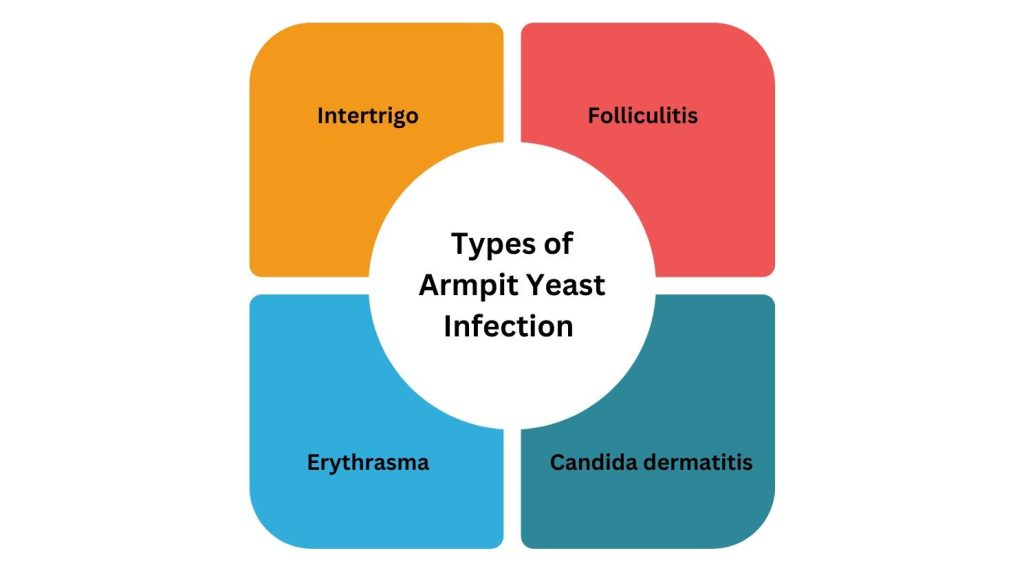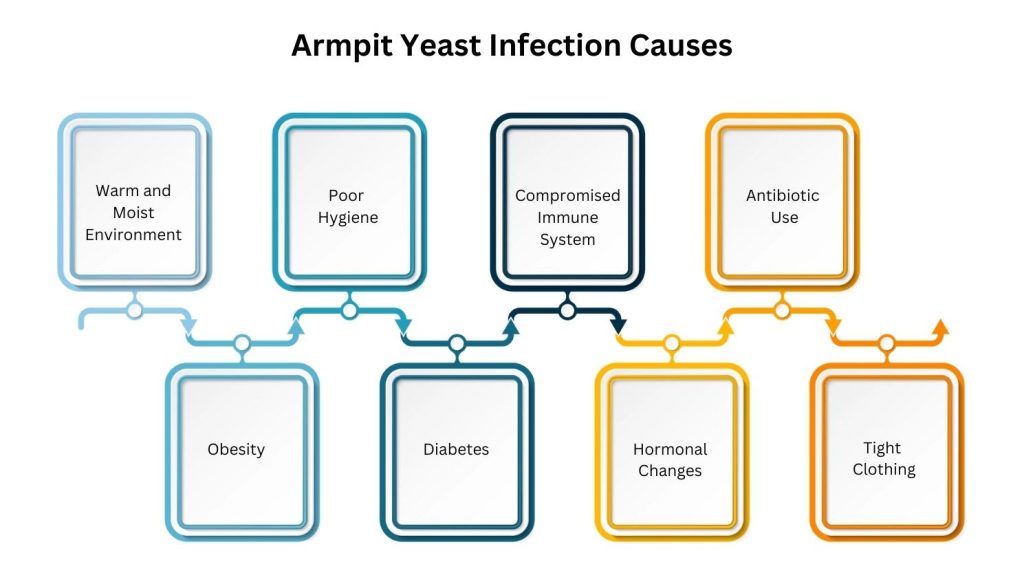Armpit yeast infections, also known as candidiasis, are fungal infections caused by an overgrowth of Candida, a type of yeast that naturally lives on our skin. These infections can be uncomfortable and sometimes embarrassing, but they are generally not dangerous and can be treated effectively.
Both men and women can get armpit yeast infections, but they are more common in individuals who sweat excessively, have weakened immune systems, or are overweight.
While the infection itself won’t kill your skin, it can cause significant irritation, redness, and itching, making it important to seek treatment promptly.
What is Armpit Fungal Infection?
Armpit fungal infection, commonly referred to as a yeast infection in the armpit or armpit candida, is a condition where the Candida fungus overgrows in the warm, moist environment of the underarms.
This overgrowth disrupts the natural balance of microorganisms on the skin, leading to symptoms like redness, itching, and a rash. The infection can be exacerbated by factors such as excessive sweating, poor hygiene, or a compromised immune system.
While it can be uncomfortable and persistent if left untreated, armpit candida is generally manageable with proper hygiene and antifungal treatments.
Do yeast infections smell?
Yeast infections in the armpit can sometimes be associated with a noticeable odor. This odor is typically described as musty or sour and is caused by the metabolic processes of the yeast itself. When Candida or other yeast species overgrow in the warm and moist environment of the armpit, they produce volatile compounds that contribute to the distinct smell.
However, it’s important to note that not all armpit yeast infections will have a strong odor, and the intensity of the smell can vary depending on factors such as personal hygiene practices, diet, and the severity of the infection.
Types of Armpit Yeast Infection
Armpit yeast infections can manifest in different forms, each presenting unique symptoms and characteristics. Here’s a look at the various types of armpit yeast infections:

Folliculitis: Yeast folliculitis occurs when hair follicles become infected with yeast, leading to inflamed, pus-filled bumps in the armpit area.
Erythrasma: Although caused by a bacterium, Corynebacterium minutissimum, erythrasma can sometimes be mistaken for a yeast infection due to similar symptoms, including red or brown patches in the skin folds like the armpits.
Candida dermatitis: This refers to a more generalized fungal infection involving the skin, often occurring in areas prone to moisture buildup, such as the armpits.
Each type of armpit yeast infection may require specific treatments tailored to its symptoms and underlying causes. Prompt diagnosis and appropriate treatment can help alleviate discomfort and prevent recurrence.
Symptoms of Armpit Yeast Infection
Armpit yeast infections, medically known as candidiasis, present several distinct symptoms that can vary in severity from mild discomfort to more pronounced irritation.

Redness and Inflammation: The skin in the affected armpit area typically becomes red, swollen, and inflamed. This inflammation may extend beyond the armpit into surrounding skin folds.
Rash or Patches: A rash-like appearance can develop, characterized by raised, red patches that may be warm to the touch. In some cases, these patches may merge into larger areas of irritated skin.
Unpleasant Odor: A distinctive, musty odor is often associated with armpit yeast infections. This odor arises from metabolic by-products produced by the yeast as it proliferates on the skin.
Pain or Discomfort: Some individuals may experience pain or tenderness in the armpit area, especially when the skin is touched or rubbed against clothing.
Burning Sensation: The infected area may feel hot or burned, particularly during activities that increase sweating or friction.
Cracking or Peeling Skin: In more severe cases or when the infection persists untreated, the skin may develop cracks, fissures, or areas of peeling.
Discharge: In rare instances, a yeast infection in the armpit may produce a thick, white discharge similar to that seen in vaginal yeast infections.
Generalized Fatigue or Malaise: Systemic symptoms such as fatigue or a feeling of general unwellness can occasionally accompany severe yeast infections, especially in individuals with weakened immune systems.
Armpit Yeast Infection Causes
Armpit yeast infections, or candidiasis, are primarily caused by an overgrowth of the Candida fungus on the skin. Several factors contribute to this overgrowth, leading to the development of an infection.

Poor Hygiene: Inadequate cleansing of the armpit area can allow sweat, oils, and dead skin cells to accumulate, providing nutrients for yeast growth.
Compromised Immune System: Individuals with weakened immune systems, such as those with diabetes, HIV/AIDS, or undergoing chemotherapy, are more susceptible to fungal infections, including armpit yeast infections.
Antibiotic Use: Antibiotics can disrupt the natural balance of microorganisms on the skin and within the body, creating an environment where yeast can thrive unchecked.
Obesity: Excess body weight can lead to skin folds and creases where moisture can accumulate, promoting yeast growth.
Diabetes: High blood sugar levels in individuals with diabetes can create an environment conducive to yeast overgrowth.
Hormonal Changes: Hormonal fluctuations, such as those during pregnancy or menopause, can alter the body’s natural pH balance and contribute to yeast infections.
Tight Clothing: Wearing tight-fitting clothing, especially in the armpit area, can restrict airflow and create friction, promoting yeast growth and irritation.
How to Get Rid of Armpit Yeast Infection?
Treating an armpit yeast infection involves addressing the underlying fungal overgrowth while managing symptoms to promote healing and prevent recurrence. Here are effective treatment options and strategies:
Antifungal Creams and Ointments
Antifungal creams containing ingredients like clotrimazole, miconazole, or ketoconazole are commonly recommended for treating armpit yeast infections. These creams are applied directly to the affected area and work to eliminate the yeast causing the infection.
Topical Antifungal Powders
Powders containing antifungal agents can help keep the armpit area dry and prevent moisture buildup, which promotes yeast growth. These powders are particularly useful for individuals prone to excessive sweating.
Keep the Armpits Clean and Dry
Maintaining good hygiene is crucial in treating and preventing armpit yeast infections. Regularly washing the armpits with mild soap and water helps remove sweat, oils, and dead skin cells that can contribute to yeast growth. Patting the armpits dry thoroughly after showering or sweating helps prevent moisture buildup.
Avoid Tight-Fitting Clothing
Wearing loose-fitting clothing made of breathable fabrics like cotton can help reduce friction and promote airflow in the armpit area, aiding in the healing process of yeast infections.
Antifungal Medications
In cases of severe or recurrent armpit yeast infections, oral antifungal medications may be prescribed by a healthcare provider. These medications work internally to eradicate the yeast causing the infection and may be necessary for individuals with compromised immune systems.
Lifestyle Adjustments
Making lifestyle changes such as managing diabetes effectively, maintaining a healthy weight, and avoiding prolonged use of antibiotics can help reduce the risk of recurrent yeast infections in the armpits and elsewhere on the body.
How Long Does Armpit Yeast Infection Last?
The duration of an armpit yeast infection can vary depending on several factors, including the severity of the infection, the effectiveness of treatment, and individual health factors. With appropriate treatment, mild to moderate cases of armpit yeast infections typically start to improve within a few days to a week. However, more severe or recurrent infections may take longer to resolve, requiring several weeks of consistent treatment. It’s important to follow the prescribed treatment regimen and maintain good hygiene practices to help speed up recovery and prevent the infection from returning.
If symptoms persist or worsen despite treatment, consulting a healthcare professional is recommended for further evaluation and management.
Bottom Line
While armpit yeast infections can be uncomfortable and irritating, they are generally treatable with proper care and management. Maintaining good hygiene, using appropriate antifungal treatments, and making lifestyle adjustments can help alleviate symptoms and prevent recurrence. Prompt attention to symptoms and consult a healthcare provider when needed can ensure effective treatment and promote skin health. Understanding the causes and treatment options for armpit yeast infections empowers individuals to take proactive steps toward recovery and overall well-being.

